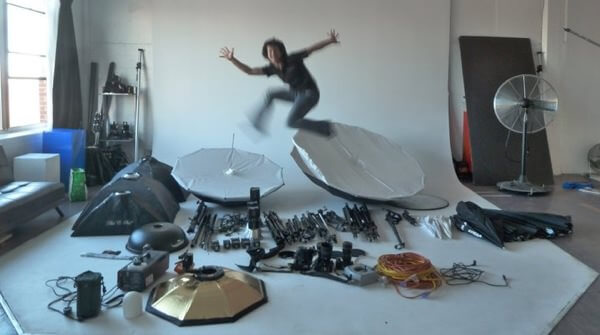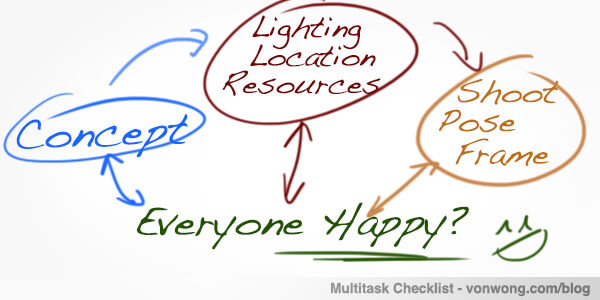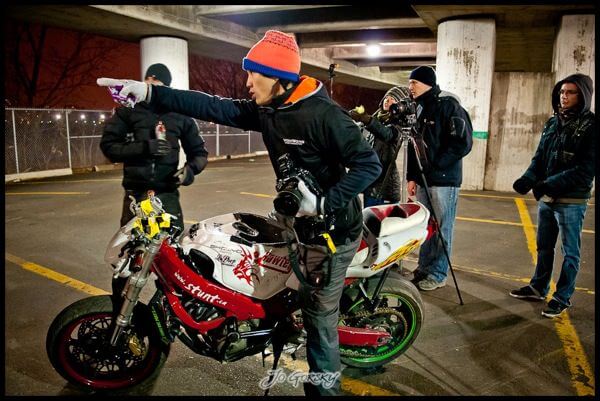After surviving a crazy 4 hour concept,shoot and edit challenge, I decided to draft up a little survival guide I thought might be useful for all of you to enjoy.
1. Know your stuff. Get it ready!
It is imperative for you to know what resources you’re going to have available to you – what are their limitations. What are the work arounds, if something breaks or fails to work, do you have a backup plan.
-
- Check your batteries, are they all charged?
- Memory cards. Without these, your camera is useless!
- Triggers: what if they don’t work? Got backups? CLS/cable/optical alternatives?
- Reflector. Bring one it’s useful.
- Tripod. Always want to have one available. Did you bring your base plate? I use the CSLR M-Plate
, so my base plate is always tightly screwed onto my camera.

2. Assess the location
Take a couple seconds to look around the space, engage the people that are there at your disposal… Figure out where you can and cannot go. Don’t be scared to ask.
-
- Is the ceiling low enough to bounce light off of?
- Any interesting objects that can help cast an interesting shadow? Plants are great for this.
- What type of ambient light are you dealing with? Can you turn them on/off?
- Which objects can be moved? What can you do to customize your set?
- How much time do you have available? Who is in charge of the building/space? Become friends with him, he might be able to open some doors for you…literally.
3. Who are the people there and what are they good at ?
If they’re there, they can be used. Figure out what the strengths and weaknesses are of each person that’s there to help you out. Establish a connection with the people and the location. If you’re shooting in a public location and people stop and stare, they can help too!
-
- Girls are better than boys at makeup and hair. Don’t have a hairstylist? Put a girl to work, she’s probably got more practice than you if you’re male.
- Figure out who has experience in photography. What equipment are they familiar with.
- If they have no experience, take a couple seconds to gather up your potential assistants to explain to them the basics (ex: Don’t put your finger here, this is the optical sensor.)
- Choose wisely. Take a couple seconds to study the people that are available and put them to use accordingly. Don’t put a 12 year old kid on lightstand + umbrella watch duty, he’ll probably get bored and run off.
- Be conscious that these are people probably helping out for free, they’re not your slaves. Be aware of what you’re asking of them. It doesn’t hurt to ask people if everything’s ok.
4. Do first, think later
If time is a very real constraint, get the ball rolling. Turn on all your equipment, take out all the light stands, set up all the softboxes. Have everything ready to go so that when you need it, it’s there.
-
- If possible, set your assistants to the task. Though they may be slower than you, delegating will free up your hands and mind. If they don’t know how but are a quick learner, get them started and tell them to figure it out.
- Try to lay everything out in a single corner. Seeing your equipment all ready to go can inspire ideas that you hadn’t previously considered.
- Don’t be scared to change things up after you’ve asked someone to do something. If for whatever reason you decide that Flash A should now have a softbox and Flash B a beauty dish instead of the other way around, it’s not the end of the world. No one’s judging you.
5. Multitask
As a photographer you’re thinking of concept, lighting, pose, style, communication, timing and more. This means that when one variable changes, the rest need to compensate and the only way to do that is to multitask.
-
- Can’t multitask? Learn. Start small and build up. You multitask on a daily basis (talking on the phone while cooking while making plans for the next day). How do you do it?
- Create a mental checklist if necessary and run through it over and over again. Here’s an idea of what goes through my mind:

6. Relate to familiar scenarios
Experience plays a huge part in these type of situations. Connect to a similar situation that you had to deal with – what are the similarities. How did you deal with similar challenges.
-
- If you’re one of those visual people, perhaps it would be handy for you to grab a set of Strobist trade secret cards
or build your own
- Have images you like in a folder on your phone. Seeing images can trigger inspiration.
- If you’re one of those visual people, perhaps it would be handy for you to grab a set of Strobist trade secret cards
7. Be confident… or act confident if you’re not.
When you hold the camera in your hand, you’re the dude (or dudette) in charge. Everyone is looking at you to pull the shots. If you look like you have no idea what you’re doing, people will quickly loose confidence in you and things will only get worst.
-
- Don’t make long uncertain “uhhmmmmm… ahhhhh…” sounds as you consider what to do next. Compliment the parts of the image that work loudly to encourage those that surround you while you panic in your head about the parts that don’t work
- Don’t chimp for too long. A quick glance should tell you how things are looking. People holding uncomfortable poses as you zoom in and consider whether you’ve nailed the perfect Rembrandt lighting will quickly grow uncertain and their pose will suffer int he long run.
- Really want to take the time to review the shot? Call a quick break
- Have a friend in the mix? Pull him/her aside and get an objective opinion… a fresh pair of eyes can help unblock whatever you’re stuck on.
- No idea what to do? Things just really aren’t working? Reset the entire set. Say to the group: “Alright this is great, lets try something new!”

Photo by Jo Gorsky – www.jogorsky.com
For those interested, this was the challenge that triggered it all!
****Are you a long term fan? Please tell me about yourself!
